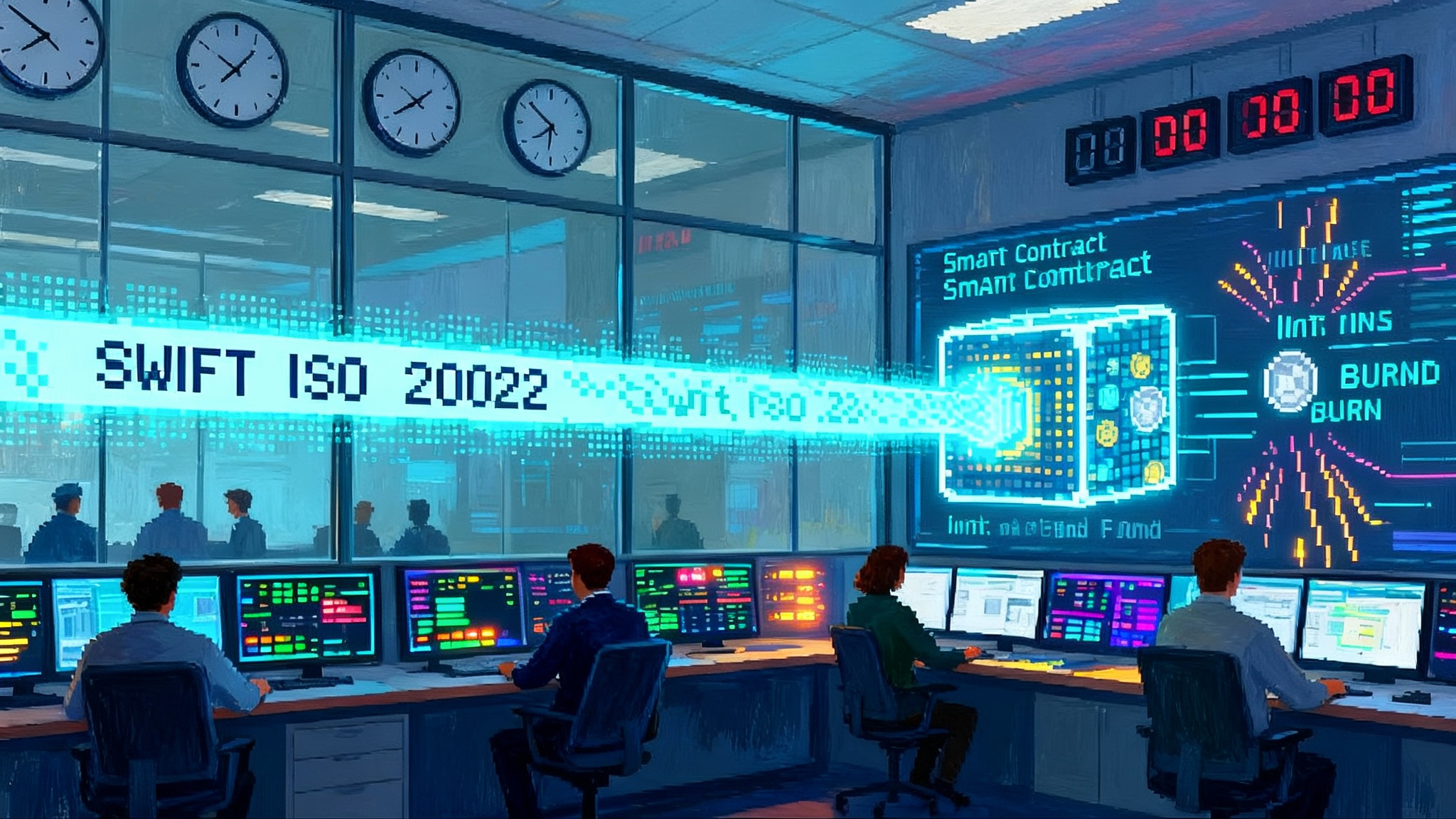Monad’s Nov 24 mainnet: can a Solana-speed EVM upend L2s?
Monad is set to launch mainnet on November 24 with a MON airdrop and a promise of Solana-like throughput inside an EVM. Here is the week-one scoreboard and how it could reshape Ethereum rollups and Solana.

The news, the promise, the question
On Monday, November 24, 2025, Monad is slated to switch on mainnet and drop MON to early users and contributors. The hook is simple and provocative. Deliver Solana-like speed while keeping the developer familiarity of the Ethereum Virtual Machine. If Monad can prove that in the wild, it does not just launch a new base chain. It challenges the working assumption that most new user activity will live on Ethereum rollups while base chains recede into settlement and data layers.
This piece is a practical lens for the first seven days. We keep the hype parked at the curb and track what can be measured. If you are a builder, market maker, validator, or fund, the checklist below is your map for week one. After that, we draw the second-order effects for Ethereum rollups and for Solana if Monad’s design holds up under live traffic.
Why a Solana-speed EVM would matter
Two ideas long ran in parallel. First, that the Ethereum Virtual Machine, or EVM, wins developer mindshare. Second, that high throughput requires a very different runtime, as seen on Solana’s Sealevel. Monad’s pitch is to collapse that tradeoff by parallelizing EVM execution and aggressively optimizing the pipeline from transaction ingestion to finality.
If that works, the immediate implication is less friction for teams already fluent in Solidity and common tools like Foundry and Hardhat. Porting code becomes a lift-and-place job instead of a rewrite. The further implication is liquidity convenience. If the execution environment is familiar and the performance is tactile, more teams will deploy the same core contracts where the flow is, then shuttle assets across. A fast EVM is not new as a concept. A fast EVM that hits real world low latency at consumer scale is the thing to watch.
What to measure in week one
The right way to handle launch week is like a field test. You do not compare taglines. You compare traces.
1) Real throughput and latency, not brochure numbers
Treat transactions per second as a system property that varies across time and load. What to collect:
- Sustained transactions per second over rolling one minute, five minute, and one hour windows during peak periods. Bursts prove the ceiling. Sustained rates prove the engine.
- Inclusion latency, measured as the time from transaction broadcast to inclusion in a block. Report p50, p90, and p99 percentiles. A chain can feel fast at median but frustrating at the tail.
- Confirmation policy. Note how many blocks or seconds wallets and exchanges recommend before treating transactions as final. The lower the operational confirmation target, the more confident operators are in safety plus liveness.
- Congestion behavior. Submit the same transaction under low load and again during spikes. Watch for fee sensitivity, reordering, and how the mempool behaves under stress.
A credible week-one outcome would show a sustained rate that is materially higher than typical EVM chains, inclusion times that feel interactive for consumer apps, and stable tail latencies as traffic spikes. A red flag would be beautiful medians with p99s that swing into seconds, plus visible reorgs that force wallets to raise confirmation counts.
2) Validators, decentralization, and hardware reality
Parallel execution loves hardware. That can create performance that is real, and also centralization pressure that is real. Measure:
- Validator set size. Count active validators at mainnet start and at the end of week one. Growth is good, but quality matters more than a headline number.
- Stake distribution. What percentage of stake sits with the top 3, 5, and 10 operators. Track the Nakamoto coefficient, defined as the minimum number of validators that can collude to halt or censor the network. Higher is better.
- Geographic and hosting diversity. Are validators concentrated on a small set of cloud providers or concentrated in one region. Outages and network partitions often follow that distribution.
- Hardware requirements in practice. Observe the machines successful validators are running. Benchmark minimums are one thing; the rigs that actually win blocks and keep up with state growth are another.
A credible week-one picture shows a validator set that is growing, no single operator with oversized control, and a mix of bare metal and cloud across regions. A red flag is a small set of operators capturing most of the stake and block production, plus anecdotal reports that only very high end machines can keep up.
3) MEV dynamics from block one
Maximum Extractable Value, or MEV, is what sophisticated actors earn by influencing transaction ordering. The first days of a new chain define norms that can last a long time. Watch for:
- Order flow pathways. Are transactions routed through public mempools, private relays, or direct to builders. The presence of private order flow on day one hints at where MEV rents will accrue.
- Builder and searcher composition. Do a few parties build almost all blocks. Do searchers who dominate other chains appear immediately. Fast arrival means the arbitrage rails are already built.
- Sandwiches and backruns inside early automated market maker pools. Sample swaps in core pairs and check for predictable patterns that indicate low latency insertion by searchers.
- Protocol-level controls. Look for any proposals or mechanisms that shape MEV, such as encrypted mempools, inclusion lists, or forms of pre-confirmations. The absence of guardrails may not be fatal, but it tells you to price more slippage in the near term.
A credible week-one outcome shows transparent pathways for order flow, multiple builders, and early conversations about MEV policy that include wallets, dapps, and validators. A red flag is opaque private order flow handshakes that start to define the market before users even arrive.
4) Early exchange support and bridges
The launch of a base asset and an airdrop is as much an operations story as it is a marketing story. Track:
- Centralized exchange support for MON deposits and withdrawals. Listings alone are not enough. The speed and reliability of deposits and withdrawals sets the liquidity tempo.
- Native bridge reliability and throughput if one is available. Monitor downtime, queue length, and receipt times. Bridges are the lifelines for builders and market makers during the first week.
- Third party bridge integrations and limits. Many teams will cap daily transfer size at launch for risk control. Those limits define how fast liquidity can truly migrate.
- Stablecoin connectivity. The availability of native or canonical stablecoins determines whether users can price and settle without pain.
A credible week-one outcome is simple. Deposits and withdrawals work on at least a few large venues. Bridges operate without emergency pauses. Stablecoins arrive with healthy mint and burn pathways. A red flag is a chain that is fast internally but surrounded by narrow or unreliable on and off ramps.
5) Developer migration that you can trace in the data
Developer intent is easy to measure in forums. Migration is a database phenomenon. Compile:
- Contract deployment counts and unique deployers per day. Watch for known team addresses that port code, not just wallets that deploy forks.
- Tooling ergonomics. Confirm that the core EVM tools and libraries work on day one without brittle patches. Build time friction kills momentum in week one.
- Canonical protocol arrivals. Track the first native deployments by established decentralized exchange, lending, and derivatives teams. If obvious protocols avoid the chain, ask why. If they arrive, follow where they route fees and incentives.
- Incentives and grants. Note whether builder incentives lean on simple emissions or targeted rewards tied to user retention and fee generation. Emissions without product fit are a sugar high.
A credible week-one outcome shows more than vanity deployments. It includes at least a handful of teams shipping production code that processes user flow, plus real integrations with wallets, analytics, and custody.
How a parallelized EVM could work in practice
A simple way to visualize Monad’s approach is a kitchen with many cooks who can work on separate dishes at once, as long as they do not grab the same pan at the same time. In technical terms, the runtime attempts to execute transactions in parallel when they touch disjoint parts of state, and falls back to serial execution when conflicts arise.
There are a few moving parts behind that kitchen metaphor.
- Dependency detection. The node attempts to predict what storage slots a transaction will read and write. Some systems require hints from the transaction. Others speculate and correct with rollbacks when conflicts occur.
- Pipelined stages. Networking, execution, and storage updates can be overlapped in time so that the machine is never idle. Think of transactions moving down an assembly line instead of waiting in a single queue.
- Scheduler policy. The system decides which transactions can run together and which must wait. The scheduler also sets block packing strategy, which affects latency and throughput under load.
- State growth and pruning. Parallel throughput is great until state size makes validation and archival nodes expensive. Successful designs pair throughput with practical strategies for state compression and data availability so that validators can stay in sync.
The risk in any parallel system is that peak numbers hide real world tail behavior. The goal is not just high transactions per second. It is predictable latency across varied workloads and resilient recovery when something stalls.
What a reset of the L1 versus L2 playbook would require
The last two years set a default view. Keep high volume activity on rollups, settle periodically to Ethereum, and periodically move assets between rollups and the base layer. To reset that playbook, a new Layer 1 needs to hit practical proof points.
- Consumer grade latency for common actions. Swaps, mints, and transfers should consistently feel instantaneous to human users, including at peak times, not just in off hours.
- Economic finality that operators respect. Exchanges, custodians, and market makers should be comfortable with short confirmation targets, which lowers inventory risk and improves pricing.
- Healthy validator and builder competition. If block production centralizes in a few parties or in one geography, sophisticated flow will stay cautious, and regulators and risk committees will turn up the scrutiny.
If these conditions show up in the first week and persist in the first month, liquidity shifts become plausible. The gravity is not ideological. It is latency and operational risk budgets.
How liquidity and builders might move
Money moves along three vectors: where it can earn, where it can move quickly, and where risk feels manageable.
- From rollups to Monad. Rollups have done the heavy lifting to onboard users and help wallets improve account abstraction and gas coverage. The friction is fragmentation. If Monad can offer a single fast venue with familiar tooling and tight stablecoin rails, market makers can aggregate flow and compress spreads. Builders who target casual users may prefer one high capacity venue over many small venues if tooling parity exists.
- From Solana to Monad. Solana offers great performance and a thriving culture of consumer apps. Monad’s offer is reach for Solidity teams that never left the EVM world. If the runtime is fast enough and the bridges are strong, multi chain teams may default to EVM plus Monad, then add Solana where latency or throughput is needed. That is not a zero sum world. It is a world where EVM familiarity becomes the shortest path to distribution. See how Solana enters multi-client era to understand the parallel advances on its side of the stack.
- Stablecoins and perps as anchors. The earliest sticky liquidity will likely be in stablecoin pools and perpetual futures. If fee markets stay predictable and liquidators can rely on latency, derivatives venues will plant flags. Where derivatives go, wallets and retail products follow, especially as stablecoins into U.S. payment rails becomes policy reality.
Second order effects for Ethereum rollups
A credible Solana-speed EVM pressures rollups to sharpen their story on a few fronts.
- Sequencer decentralization and latency. Single sequencer designs are easy to optimize but hard to decentralize. Expect faster movement to shared sequencing, based sequencing, or other designs that let several parties schedule transactions while preserving speed and fairness.
- Data costs and compression. If users feel fee relief on Monad, rollups will race to compress their data availability footprints and pass savings through to users. Expect new proofs, better batch strategies, and aggressive use of data availability layers.
- Cross rollup liquidity. Bridges between rollups are still early. If a fast EVM base layer becomes a liquidity magnet, rollups will need richer shared liquidity designs, not just point to point bridges.
- Wallet experience. Rollups win when wallets make fragmentation invisible. Expect more wallets to abstract accounts across several rollups and to sponsor gas where feasible, building on advances like passkeys make smart wallets the default.
Second order effects for Solana
Solana has pushed the ceiling on throughput and low latency user experience. A fast EVM base layer would adjust the competitive set rather than turn it into a binary choice.
- Developer calculus. Teams that live in Solidity and EVM tooling might find it cheaper to get to market on Monad, then expand to Solana when they need ultra low latency workload patterns or when they want to target Solana’s user base. Solana native teams will continue to have an advantage in programs that rely on tight parallel execution and custom runtimes.
- Liquidity bridges and unified front ends. If Monad becomes a magnet for EVM liquidity, expect more interfaces to route orders across both ecosystems. Users will not care which runtime serves a click if the experience is smooth and fees are predictable.
- Performance counters. Solana’s client and runtime work will continue to push p99 latency down. If Monad succeeds, everyone benefits from a race that makes blockchains feel real time to end users.
A pragmatic playbook for week one
If you are trying to make decisions in the first seven days, use a test plan. Here is a simple, concrete checklist.
- Set up a small suite of bots that submit transfers and swaps every few seconds at varying sizes. Capture timestamps at send and at inclusion. Publish the p50, p90, and p99 every hour.
- Run the same suite during coordinated stress windows. You do not need to spam the chain. You only need to measure performance under conditions that users will encounter when real products launch.
- Track the top validators and builders by output and stake. Refresh the distribution daily. Alert on concentration above reasonable thresholds.
- If you operate exchange or market making infrastructure, run pilot deposit and withdrawal flows with small balances to validate operational confirmations and reorg exposure.
- If you are a team considering a deployment, port one small but real component first. A fee collector, a relayer, or a module that reads and writes modest state. Measure build time and the reliability of the toolchain.
- If you are a wallet, map the signing flows and error paths for users with weak connections and low powered devices. A fast chain is only useful if the last mile is reliable.
Risks and failure modes to keep in view
No launch is free of risk. Being explicit about the failure modes helps you react faster.
- Centralization drift. If hardware needs creep up, block production can cluster in a few hands. That can show up as short confirmation targets that only a small set of market makers trust.
- Congestion cliffs. A parallel scheduler that delivers great medians can still hit cliffs at high contention, especially around shared state like popular pools and vaults.
- MEV opacity. If private order flow becomes the default, slippage and user experience can degrade faster than aggregate throughput improves. Builders will then need to add more user protection.
- Bridge incidents. Early bridges carry risk. A hiccup can slow migration and force risk limits that crimp liquidity.
- State growth and node churn. If state expands quickly without efficient pruning and snapshots, it becomes harder for new validators and archival nodes to join and for existing ones to keep up.
The scoreboard that matters by Friday
By Friday, November 28, 2025, the best early indicators will be visible to anyone willing to look. You want to see three things.
- Predictable user experience. Inclusion and confirmation that feel instant at the median and stay below one second at the tail in busy windows.
- Healthy production competition. Multiple builders and validators sharing output, with no single operator holding an outsized share.
- Real deployments and real flow. At least a few flagship protocols running in production with measurable daily users and volume, plus stable bridges and exchange flows that do not require manual babysitting.
If those show up, capital and builders will follow. Not all at once, not everywhere, but enough to bend roadmaps.
The take
Monad’s mainnet and MON airdrop give the industry an ideal experiment. Can a parallelized EVM deliver consumer grade performance while preserving the developer familiarity that has made the EVM the default execution environment. If yes, the L1 versus L2 debate becomes less of a ladder and more of a field, where a fast base chain and specialized rollups both move users forward. If not, the lesson will still be useful. We will learn where parallel EVM designs hit friction, and which parts of the stack need new thinking.
A breakthrough is not a press release. It is a week of traces, a month of uptime, and a quarter of developer retention. Watch the numbers. Ship small pilots. Do not confuse bursty peaks with durable capacity. If Monad turns week one into a steady drumbeat of performance, reliability, and credible decentralization, it will have earned more than attention. It will have earned flow. And in this market, flow decides where the map gets redrawn.








